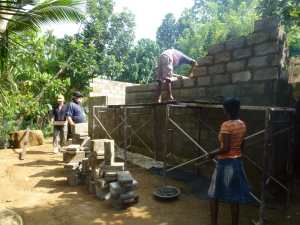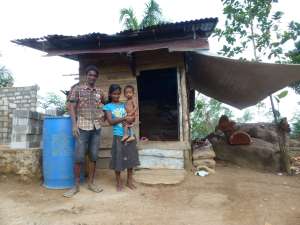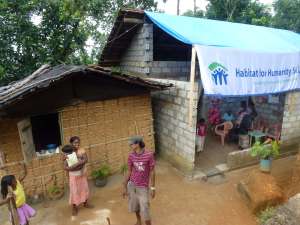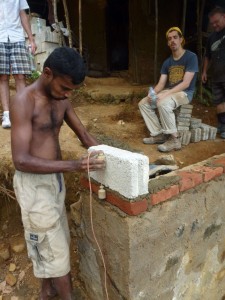In November 2012, Alan Murray, former CCES Associate Director travelled to Sri Lanka with his daughter Rebecca to volunteer their time to help build new housing for displaced locals. Here is the narrative of the trip as recounted by Alan:
Seventeen volunteers arrived in Sri Lanka in mid November and travelled by bus from Colombo to Unawatuna near Galle on the south coast of Sri Lanka (an area that had been completely devastated by the Tsunami). We were destined to spend 5 days working in the village of Thalgasyaye, some 30 minutes drive into the mountains behind Galle. This is a very poor village where families have been given permits to build homes on an old government palm tree plantation. Many of the villages are currently living in 1-3 room houses made of mud, sticks with black plastic roofing – they have electricity but water is drawn from wells in the area.
As an example one of the families consists of the husband, wife, one son (13) and 3 daughters (11, 8 and 4) The husband is a bus conductor and earns about 20,000 rupees (A$150) per month. Habitat recognises his repayment of loan capacity is about 1450 rupees (A$11)/month. From the money you donated Habitat provides a interest free loan sufficient to buy cement bricks, cement, sand and gravel. Recipients are expected to dig the foundations and assist in building as part of their commitment to the housing and as I doubt these owners received long service leave, their absence from work to build the houses shows strong determination and commitment.
So what did I do? I have attached some photos for your info. One of the main problems was the access road to the village only allowed small trucks to deposit the 12 kg bricks, gravel and sand on the edge of the road – these then needed to be transported by hand up (or down) the mountain to the building site. Rather carry one brick at a time the group formed a ‘conga’ line and passed the bricks, sand etc along the line to the site. Assistance on the site with mixing mortar, passing bricks etc then occurred. The temperature in the mid-30s, high humidity and the sun meant we had to drink lots of water.
Despite this, after 5 days, 3 houses had been finished to the point where the families could move in, 6 had been finished to the level of the lintels for roofing to be added and one (where rocks caused huge digging problems with the foundations) had half the walls raised. On the Friday afternoon, there was a strong feeling of accomplishment and speeches by the matriarchs of the village showed enormous emotion and gratitude.
From my view point, this was an experience that was well worthwhile and with further building activity in the area scheduled it means families are able to move into stable, but basic, permanent accommodation rather than living in very sub-standard housing with their spouse and children.




